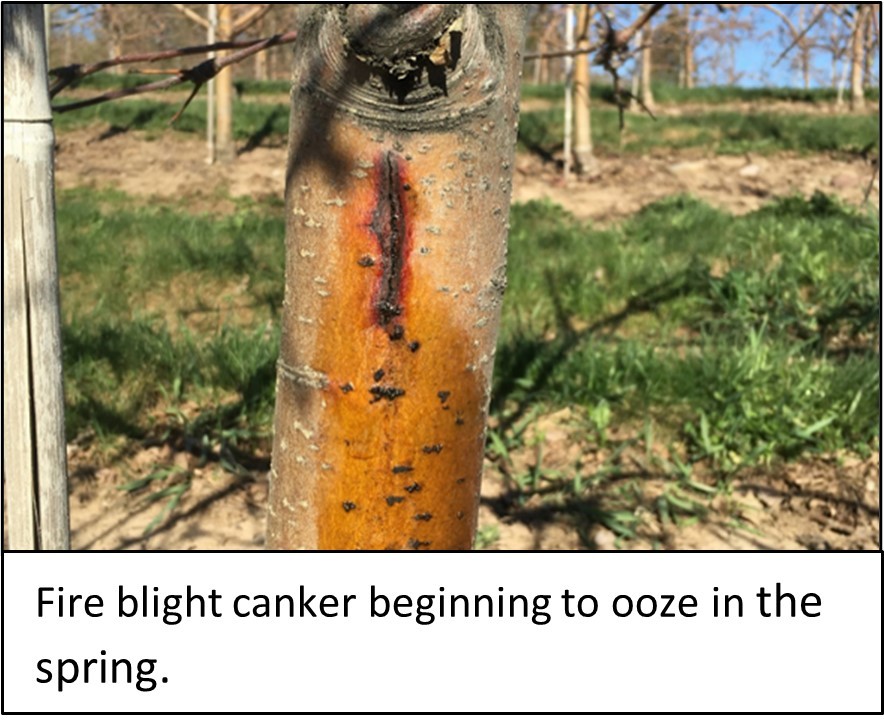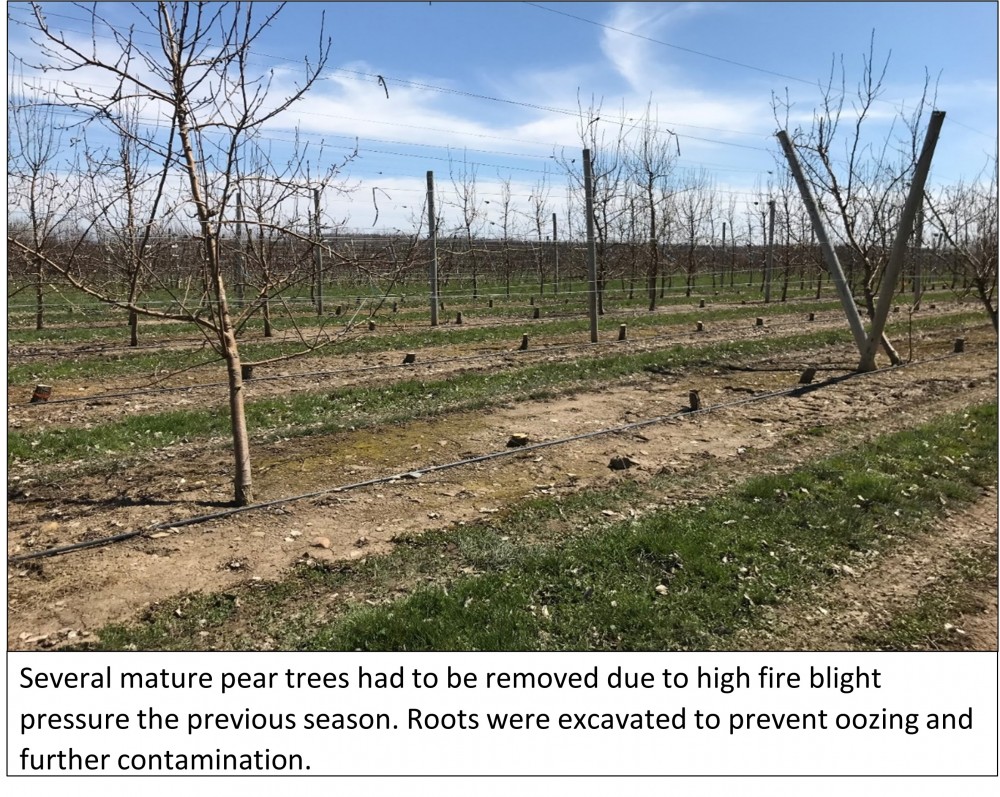Winter pruning to manage fire blight (while continuing to grow the trees)
By Janet van Zoeren, Kerik Cox, Anna Wallis and Mario Miranda Sazo
Winter pruning is always an important time to begin your fire blight management program for the season, and this year especially much so. Winter canker removal could make the difference for you between starting spring 2021 with "normal" fire blight pressure, versus potentially giving yourself a handicap by keeping around lingering bacteria from last year's difficult season.
Here we discuss some reminders of how and when to prune for fire blight management, and some tips for how to continue to grow the trees in areas with more severe damage.
Winter/Spring pruning in 2021: Remember that Erwinia amylovora bacteria can only survive in the orchard on or inside of living tree tissue, particularly at the margin of cankers. So, the more cankers you remove now, the less bacteria you will have to contend with in the spring.

Keep your eyes open (and train your crew to keep an eye open) for cankers in all blocks as you are pruning this winter. Hopefully you marked on a map or flagged areas of high fire blight pressure last summer, so you can pay especially close attention for cankers in those areas. In blocks with high pressure last year, we recommend taking a few extra passes down those rows, focusing just on looking for cankers without the distraction of general pruning decisions.
Fire blight cankers appear as dark or black, cracking "scorch marks" on the bark, and often the leaves or leaf stems remain on the tree through till spring. These may not be oozing, but do not discount them.
When deciding where to cut when removing a canker, we recommend you use a hatchet or knife to peel bark away from the tree until you see healthy green tissue. Make your pruning cut approximately 4 inches into 2nd year wood. If the canker is in older wood prune 10-12 inches before the edge of the canker. If there are too many cankers in a block to warrant that level of detail, you can instead simply make the cut 3 feet before the canker in young vigorous trees, and 18 inches before in older slow-growing trees. In all cases, cutting beyond different ages of growth is the best practice as the fire blight pathogen moves across junctions between new and older tissue more slowly.
For trees 2 years old or younger, it is often safer/ to just pull the entire tree and replant later. For example, in the pear orchard image below, trees struggled with fire blight throughout the 2019 growing season. All trees were removed in winter 2019/2020, and roots were excavated by early April 2020.
When the tree is growing, the bacteria will be moving and growing. During winter both the trees and the bacterium are dormant, so cuts can be made safely and equipment sanitation is not a concern. Make sure to remove cuttings or let them dry out in the orchard over the course of the remaining winter months. By the time temperatures reach ~40F, Erwinia bacteria will begin growing.

Prioritizing blocks by Evaluating risk. Take a good look at your orchard and the specific blocks within your orchard. Not every block will require the most aggressive management, and frankly, there isn't enough time to provide vigilant scouting and management to every tree or every row. Prioritize blocks *you may even consider ranking them* and tailor your management (this winter and during the growing season) based on characteristics that will contribute to likely disease pressure.
- -Disease pressure: Did this block have fire blight last year? Has it ever had fire blight? If not, it is a very low risk block and requires less management.
- -Variety and rootstock: Evaluate the susceptibility of the cultivars planted in each block and where possible include resistant varieties in new plantings. (https://blogs.cornell.edu/applevarietydatabase/disease-susceptibility-of-common-apples/)
- -Tree age and planting system: Newly planted trees and high-density systems are at much higher risk of quickly being devastated. These trees have vigorous shoot growth, which is most susceptible to fire blight. In smaller trees, fire blight can quickly travel through the vascular system to the central leader, killing the tree, or travel systemically to the rootstock, girdling and killing the tree.
Tips to maximize safe grow of a new 2021 leader in a young tree that was heavily pruned due to FB in 2020:
For trees that were pruned back aggressively in the spring of 2020 to slow spread, we expect that a healthy tree will respond by growing many new shoots in 2021. To keep the tree growing vertically, the new shoots can be pruned to a single shoot (trained as a new central leader), to continue growing the young tree in newer plantings or to rapidly reach mature height in older plantings. For older plantings, the selected shoot should be of medium vigor without side shoots, hopefully with fruit spurs that will produce apples that will bend and weaken it in subsequent years. In the case of young trees that were heavily pruned and tree height was significantly reduced, we recommend you salvage tree structure and reconstruct it by selecting and training the most optimal shoot where the leader was cut off. If the trees are too devastated by fire blight, it may be less frustrating to replant than try to retrain. If you do decide to retrain, try to choose the new leader so that it keeps the best possible vertical positioning of the old trunk section.
- -Select the new leader when 2-4" long and cut competing shoots back with clippers to 2" long to prevent competition with the leader
- -Train the new leader to the wire (ideally also to a vertical element 'bamboo', 'plastic twine', 'wire') with a rubber band, tape gun, or a wire loop as soon as it reaches each successive wire
- -Apply 2-3 small doses of nitrogen to gently promote growth of the tree in 2021
- -Use of PGRs can also promote 'vertical growth' of the new leader when trying to reconstruct a heavily pruned young tree due to FB (Promalin will promote maximum vertical growth/less feathering. MaxCel will promote better tree feathering/less vertical growth.)
- -Water the trees (when needed) using trickle irrigation with low doses per tree but frequently
- -Remove flowers manually or chemically
- -If planning to crop the young tree in 2021, the unsupported terminal portion of the new leader above the last wire should be de-fruited for maximum shoot growth and good lignification during years 2, 3, and 4
- -Pay close attention for signs of fire blight (train your crew for early detection), especially in blocks that are being pushed to fill space (with aggressive nutritional programs).
- -If the tree doesn't respond to the above practices, it may be worthwhile to replace the tree to ensure that it doesn't become a source of fire blight in the coming season.
Upcoming Events
2024 Tree Fruit & Small Fruit Twilight Meetings
April 25, 2024 : Tree Fruit & Small Fruit Twilight Meetings 1 of 4
Newark, NY
Join specialists Janet Van Zoeren, Anya Osatuke, and Anna Wallis for a conversation about fruit and berry phenology and pest management, at a new location each month.
May 30, 2024 : Tree Fruit & Small Fruit Twilight Meetings 2 of 4
Lockport, NY
Join specialists Janet Van Zoeren, Anya Osatuke, and Anna Wallis for a conversation about fruit and berry phenology and pest management, at a new location each month.
June 27, 2024 : Tree Fruit & Small Fruit Twilight Meetings 3 of 4
Penn Yan, NY
Join specialists Janet Van Zoeren, Anya Osatuke, and Anna Wallis for a conversation about fruit and berry phenology and pest management, at a new location each month.
July 25, 2024 : Tree Fruit & Small Fruit Twilight Meetings 4 of 4
Mexico, NY
Join specialists Janet Van Zoeren, Anya Osatuke, and Anna Wallis for a conversation about fruit and berry phenology and pest management, at a new location each month.
2nd Annual WNY Fruit Grower Tour
August 13, 2024
We are excited to announce the second annual Western New York Fruit Grower Tour, the premier fruit tour of the northeast brought to you by Cornell Cooperative Extension's Lake Ontario Fruit Program and Lake Ontario Ag Consulting, LLC! Located in Orleans County, this orchard field day will highlight new and existing products, chemistries, practices, technologies & equipment that shape the orchard industry today. The Western NY Fruit Grower Tour will again combine two past orchard tour events, the LOF Summer Fruit Tour and the Wayne County Fruit Grower Tour, giving industry members the opportunity to conveniently showcase their product offerings to ONE unified group at ONE time and place!
Save the Date - Western NY Fruit Conference - February 4-5, 2025
February 4 - February 5, 2025 : Western NY Fruit Conference
Rochester, NY
For the 2nd year in a row, we'll be having the Western NY Fruit Conference at the DoubleTree by Hilton Hotel in Rochester! It will be another 1 1/2 day conference. Stay tuned for program and registration info as we get closer.















